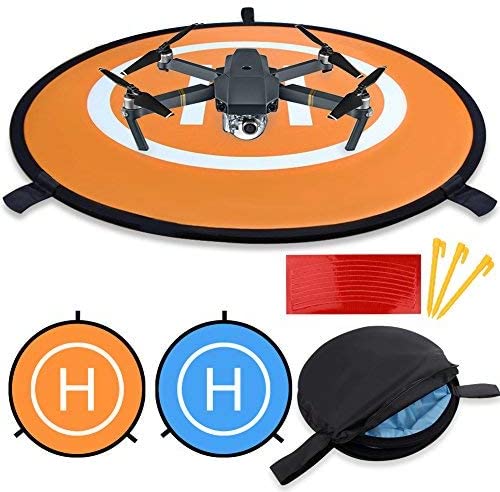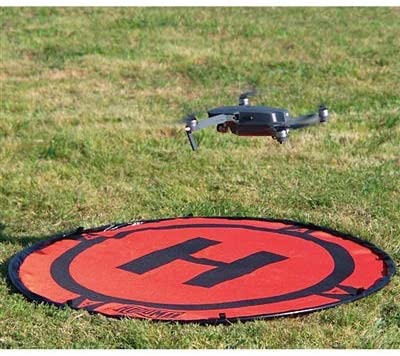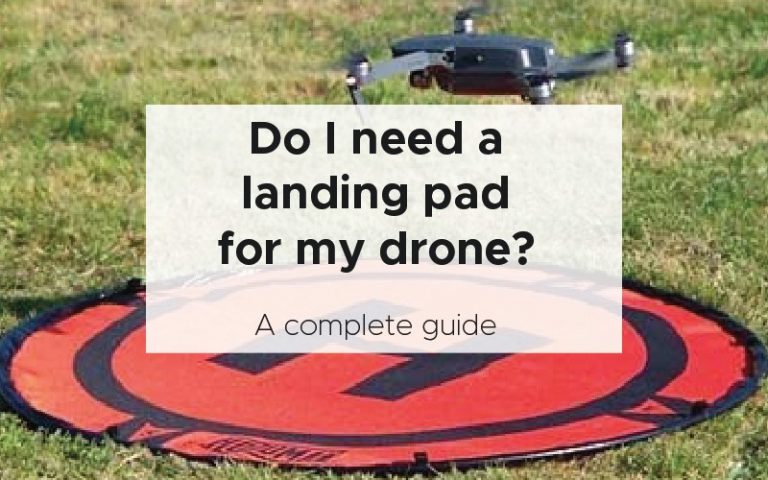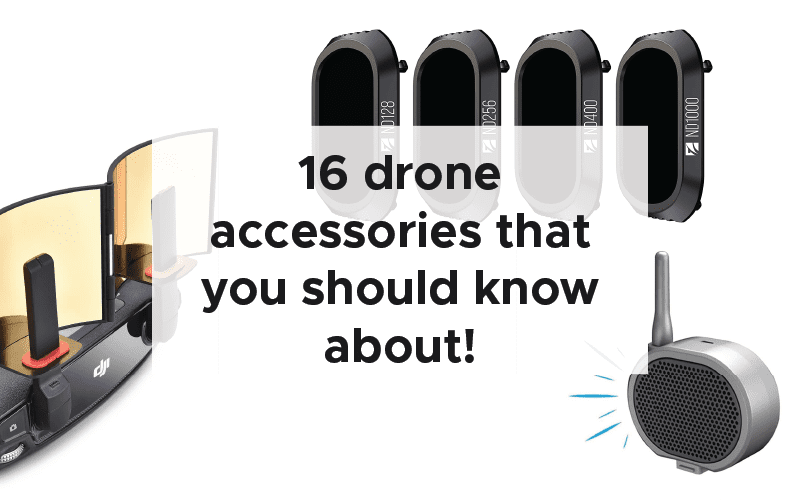When you have spent a lot of money on a drone, you want to make sure you look after it as much as possible. One of the most common accessories people use is a drone landing pad. A drone landing pad will help protect your expensive new gadget and any potential damage to your drone during landing. Most drone accidents and incidents happened during take-off and landing. So, anything that can help make that part of the flight a little bit safer is worth the small investment you need to make. Here, we are in a look at the question: do I need a landing pad for my drone? The answer will ultimately come down to where you are regularly flying and the amount of space you have.
You do not need a landing pad for your drone. But it is one of the best investments you can make to protect your drone from dust, snow, grass, rocks, and other loose items around your take-off and landing point.
The smallest rock can damage the propellers and the tiniest speck of dirt can get into the gimbal’s and motors and cause issues. This relatively inexpensive accessory will save your drone from a load of issues. So, you don’t need one, but you should probably buy one!
Before we get started let’s have a look to see exactly what a landing pad is.
What is a landing pad?
A landing pad is a circular or square piece of waterproof and robust material that springs into shape using metallic or plastic guides around the outer edge.
It packs down into a small case which means you can take it easily to your takeoff point. Owning a landing pad provides a number of benefits including, being brightly coloured so that you can find your landing spot easily, protects your motors and camera gimbal is from dust and dirt, allows you to take off on snow, sand and grass, and ultimately protects your drone during the riskiest part of your flight – the takeoff and landing. All of these we will go through in detail in the next section.
A landing pad is relatively inexpensive and can be picked up for as little as US$11.
Considering that you are purchasing a drone that can cost several thousand dollars, this small investment can help with the maintenance and protection of your drone.
When you take off the propellers cause a lot of downwash (this downwash is that air that the drone forces dam was in order to take off). The dam wash can easily dislodge dust, dirt, and large stones that can chip the propellers.
I’ve even had an incident where a relatively large stick was forced into the propellers. A landing pad protects the area underneath the drone from the Dane wash and stops any potential hazards from coming into contact with your drone.
Here are the top reasons why you should consider buying a drone landing pad.
Top reasons you need a drone landing pad
A drone landing pad is probably one of the first accessories that you should buy. It’s not often I recommend buying an accessory when you are a beginner – but this is one of them. If you want a full list of some of the best drone accessories, check out my other article – the 16 best drone accessories that you should know about! – Click here.
If you don’t already have one, these are the reasons why you should buy one.
Uneven ground
Unless you have been to a flight area before – you are very unlikely to know where the best place is to take off. Even when I have been to locations that I am familiar with, I always end up taking off in a different place. Quite often, the best place to take off is where there is a lot of human foot traffic. In nature that is on uneven, dusty, and sloping ground.
Having a drone landing pad means that you can takeoff easier on uneven ground. It doesn’t provide a solid surface, but what you can do is use it to provide a smoother surface than what is naturally available to you.
By laying the material over the ground you are able to take out the lumps and bumps that could cause your drone to lay unevenly. Sometimes, I even use my backpack or other things I am carrying with me to level the drone landing pad.
Uneven ground is one reason, but there are many more important factors to consider when buying a drone landing pad. One of them is where you are normally taking off.
Snow, sand, grass
The biggest question you need to ask yourself when buying a drone is: Where I’m am I most likely to fly it? For most people, arguably, the reason they bought a drone is to fly in some spectacular places around their house. Spectacular places do not have flat open areas that are suitable for taking off. They often have surfaces such as grass, sand and in winter – snow.
The great thing about a drone landing pad is that you can take off on any of these things. The drone landing pad stops the Dane wash from dislodging any snow or sand and flattens grass in the immediate area of the takeoff spot so that your drone remains safe and secure while launching and landing.
One of the best places I like to fly is the beach. There is no way that my drone would be able to take off on a beach without a landing pad. The landing pad, literally, gives me the ability to take off in places that I couldn’t take off from otherwise.
If you live in a place where it snows regularly having a drone landing pad means you can takeoff directly on top of the snow. Capture those awesome white landscapes with the minimum of effort.
Protecting the propellers of the drone is your number one priority for a safe flight. Making sure that the leading edge of the propellers stay intact and without damage will ensure that your flight remains stable, safe, and your drone returns from another outing safely.
Dust and dirt
There is nothing more damaging to small electronic items or tiny motors than dust and dirt. A drone contains tiny motors in a range of locations:
- camera gimbal – the camera gimbal contains a load of tiny motors and stabilisers which can easily get dirt and dust in the moving parts.
- Propellers – the propellers are attached to brushless motors which turn incredibly rapidly and smoothly lifting the drone into the air. Without the reliable and smooth operation of these tiny motors the drone would not takeoff. Damage to even one of these motors will cause instability and your drone to stop flying.
- Landing gear – some of the more expensive models of drones have extendable landing gear which requires small motors to extend the legs. Getting dust or dirt into the motors will mean the drone will not be able to land without landing directly on top of its payload – which is commonly a very expensive camera.
Also, the drone contains a number of small air vents to cool down the electronics during flight. You need to keep dust and dirt out of those as a top priority. While a drone is flying a lot of heat is generated. That is because there is a huge energy transfer from the lithium polymer battery to the motors via the electronic circuitry. This inevitably causes heat. We need to make sure, as drone pilots, that a drone is free of dust and dirt and the air vents are free from obstruction. Anything that restricts the airflow can result in the drone overheating and in the worst cases – catching fire.
Therefore, it is so important that the smallest amounts of dust and dirt are taken seriously. Even the smallest amount exposed to regularly can build up and cause serious issues with your drone.
Visible landing spot
Many drones have incredible GPS location capabilities. Others have precision landing and takeoff features that take a photograph of the environment underneath the drone.
Having a drone landing pad which is normally a bright orange or blue colour, can help improve the automatic landing of the drone. Also, if you are flying manually and landing manually having a bright, visual marker while landing is a really effective target that you cannot miss.
When you are landing from many hundreds of metres in the sky the bright and large landing pad can be hard to miss.
Drone landing pads come in a variety of colours. Orange is the best for green and forestry type environments as it stands out against the green surroundings.
Often, the drones also have a blue colour on one side this is great for sand, snow, and other contrasting environments. To be honest with you, I only ever really use the orange side – I guess that is because of my takeoff locations being in a green scenery. But, use the best colour for you i.e. the one you can see the most easily.
Now you know how a landing pad protects your expensive drone from the environment in the landing spot let’s take a look at the most important features that you need to consider when buying a landing pad for your drone.
Features to look for
Not all landing pads are made equally. The type of drone that you have will be one of the biggest dictators of which drone landing pad you should buy. That is because each drone is a different weight and will require a different downwards force to takeoff.
It is surprising how much even the smallest of drones can displace from a takeoff area and large professional drones can cause a fair bit of downwash and turbulence. That means that taking into account the size of the drone landing pad is one of the most important features to consider.
Size
before buying a new drone landing pad you need to figure out what the extended arm length of your drone is. The landing pad should provide full coverage for the footprint of the drone with a good margin of error. That will stop any way would grass blades coming into contact with the drone propellers from the edges of the drone landing pad. For small to medium-sized drones you probably only need a 20 x 20” takeoff pad. Although having a 30-inch landing pad is probably better.
If you have a professional drone, you need to buy the largest pad possible. Let’s take a look at the options for stability.
Stability
Many of the drone landing pads require you to peg at 3 to 4 points around the drone takeoff. This is because the drone landing pad can easily become dislodged as the drone initially takes off. There are a few ways that drones can be made stable. This includes:
- pegs – sand pegs and other tent-like pegs are one of the easiest ways to secure the drone to the surface. However there are some rocky areas where this would not work as well. That is when you need to consider other options.
- Self weighted – the Hoodman HDLP3 is a self weighted drone with a 3.2-pound zinc coated perimeter cable to keep the drone in place with eight stakes. This is perfect for those that want to keep their kit minimal and easy to transport.
- Anchored with weights – the New 2021 Weighted OR Anchored Drone Landing Pad 30” has weighted points at four areas on the perimeter of the landing pad. This means that you can attach the weights and the drone landing pad will be secure on any surface. You can even fill the weighted bags with sand if you are at the beach. Doing away with the need for pegs.
Making sure that your drone landing pad doesn’t just become another hazard during your takeoff and landing is so very important. You need to consider the state ability aspect of the drone landing pad seriously and by a pad that can be stabilised in the areas that you want to fly.
Colour
Colour is an important part of the drone landing pad. They come in a range of colours such as, orange, blue, red, black, yellow, and many more. The important thing is that you can spot your drone landing pad while hovering at a few hundred feet. Even though the GPS location in a number of consumer drones is more than enough to land your drone – having a visible spot will give you a little bit of insurance and a second option should the GPS or compass fail while flying.
Visually bringing in a drone is a little bit more difficult than you would think especially if you don’t have the first person view available.
The important thing is that you choose a drone landing pad that has a contrasting colour to your surroundings. For example, in a green luscious natural area, you are better off using orange. However, any “unnatural” colour will be more than enough to spot from a high hovering distance.
Portability
Clearly, one of the most important things about the drone landing pad is that it is small and portable enough that you will actually take it to your drone flying adventures.
Pretty much all of the commercially available drone landing pads are able to be reduced in size and fit in a small zipper bore container. Normally it is about ¼ of the size of the actual landing pad.
The most important aspect is the size and the weight. You need a carrying case that is well-made and has a strong industrial zip so that it does not break from using it every time you fly.
Don’t get too carried away with all of the extra accessories that your drone landing pad comes with. You need to keep your on location gear as simple as possible so that it is easy for you to set up and fly away without too much hassle.
Waterproof
Finally, another important aspect is that it is waterproof and rustproof. If there are any metallic elements you need to make sure that it does not corrode – particularly in strong corrosive environments such as by the ocean – and that the metal in the room remains intact.
There have been many flights where I have thought that it would not rain only to be surprised when the rain eventually falls. No matter how you liked the drizzle even the smallest mate of rain can cause issues with a non-waterproof landing pad.
It is also important for it to be waterproof so that you can clean it easily by wiping it down with a damp cloth. This will get rid of any of the dirt and dust that has been kicked up by the downwash and landed on the drone landing pad.
There are all of the most important things about drone landing pads and the features that you should look out for. Now let’s take a look at the best drone landing pad that you can buy for your drone and the options that you have.
Best drone landing pads

A drone landing pad is a must have in your carrying case. It protects your drone from a wide variety of potential hazards. A landing pad is perfect if you are always taking off in rough terrain for example, if you operate in the country, regularly take off on beaches, or have to land in the tallgrass. The landing pad provides a perfect solid surface as well as a great target for you to land on.
A good landing pad will have bright blue and orange sides so you can select the best colour for the terrain you are in and have pegs so that it stays in place in the windiest of conditions. A large landing pad will mean that the downwash does not displace any loose rocks or do when coming into land.
If you own a small drone you particularly need one of these. If you have a drone like the DJI Mavic mini, it will protect the fragile props from getting debris is in the motors and also protect the camera gimbal. An inexpensive accessory that will save your drone from damage due to annoying bits of dirt and stones.

This drone landing pad is the professional alternative to the budget option above. It is a 3 foot in diameter drone landing pad with a variety of awesome features. It is easy to set up and springs into shape when released from a 13-inch carrier bag.
A 3.2-pound Zinc coated perimeter cable keeps the drone launchpad in place without the need for stakes or other weighted accessories. It is a little bit pricier than the other drone landing pad on the list but I think the extra price is well worth it for a professional product that you can trust and will last you for many years to come.
Conclusion
There is everything you need to know about drone landing pads including the features and most important aspects of buying a drone landing pad. Remember, that you don’t necessarily need a drone landing pad but it should be something, an accessory, that most beginner drone pilots consider using from the moment they buy a drone.
Happy drone flying my beautiful drone flying friends and keep that drone safe!





